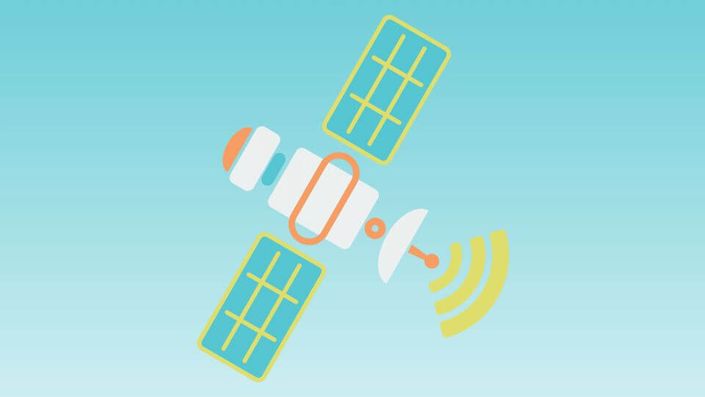
Introduction to Orbital Mechanics
Learn The Basics of Elliptical Orbits
What is Orbital Mechanics?
Orbital Mechanics, also sometimes called Astrodynamics, covers the motion of orbiting bodies like satellites and space vehicles that move under the influence of gravity.
If you're looking for a course that applies material learned from Physics, Dynamics, Calculus, and more, this is the class for you! We'll start off by deriving the 2-body relative motion equation. Then we'll work our way through the derivations of the trajectory equation, Kepler's equation and more. Orbital elements will also be covered. The Numerical Analysis topics Newton's Method and the 4th order Runge Kutta method will be taught as well and used in the projects.
This course will focus on the most common type of orbit: the elliptical orbit. Although there are other types of orbits, the elliptical orbit provides a great entry into the world of orbital motion.
To enhance your learning, homework sets are provided. These problems will let you apply what you've learned in the lectures. Then, if you want more of a challenge, MATLAB projects are given that combine our Orbital Mechanics material with techniques from Numerical Analysis. Never had a Numerical Analysis course? No worries! We'll cover everything you need to know.
Topics We'll Cover In This Course
- Relative 2-body equation
- Angular momentum
- Polar coordinates and energy
- Trajectory equation
- Elliptical orbits
- Kepler's laws
- Kepler's equation
- Newton's root finding method
- Orbital elements
- Conversion from position and velocity vectors to orbital elements
- Conversion from orbital elements to position and velocity vectors
- 4th order Runge Kutta method
- Reduction of 2nd order differential equation to a system of first order equations
- and more!
Click here for the full curriculum
Here's What You Get With Introduction to Orbital Mechanics
- 7+ hours of on-demand videos featuring easy-to-follow lectures
- Fully-worked examples in a range of difficulty levels
- Downloadable outline of notes to help you follow along with me in the lectures
- Downloadable equation sheet that contains all the important equations covered in class
- 4 homework sets for you to apply the knowledge learned.
- 3 MATLAB projects to further enhance your learning
- Certificate of Completion once you finish the course
- An experienced instructor with 20+ years of university teaching experience & 8 years of industry experience
- Email access to the instructor if you need help on course content
- 14-day money-back guarantee. Please see the Terms of Use here for more details.
Course Curriculum
-
StartDownloadable Equation Sheet
-
StartDownloadable Orbital Mechanics Outline of Notes
-
PreviewLecture 1 Introduction (16:17)
-
PreviewLecture 2 Relative 2-Body Equation & Angular Momentum (27:29)
-
PreviewLecture 3 Polar Coordinates & Energy (20:59)
-
StartLecture 4 Trajectory Equation (18:55)
-
StartLecture 5 Elliptical Orbit (18:09)
-
StartLecture 6 Elliptical Orbit Continued (18:16)
-
StartLecture 7 Keplers Laws (13:56)
-
StartLecture 8 Example 1 (23:02)
-
StartLecture 9 Example 2 (16:07)
-
StartLecture 10 Circular Orbits (8:39)
-
PreviewHomework 1
-
StartHomework 1 Solutions
-
StartLecture 11 Keplers Equation (27:38)
-
StartLecture 12 Newtons Method (18:01)
-
StartLecture 13 Newtons Method for Keplers Equation (8:07)
-
StartLecture 14 Example 5 (20:36)
-
StartLecture 15 Example 6 (10:53)
-
StartHomework 2
-
StartHomework 2 Solutions
-
StartLecture 16 Orbital Elements (21:19)
-
StartLecture 17 R V to Orbital Elements (20:54)
-
StartLecture 18 Example 7 (22:57)
-
StartProject 1
-
StartLecture 19 OE to RV (5:45)
-
StartLecture 20 Example 8 (17:15)
-
StartHomework 3
-
StartHomework 3 Solutions
-
StartProject 2
-
StartLecture 21 4th Order Runge Kutta Method (8:42)
-
StartLecture 22 Example 9 (19:31)
-
StartLecture 23 Example 10 Part 1 (30:55)
-
StartLecture 24 Example 10 Part 2 (10:37)
-
StartHomework 4
-
StartHomework 4 Solutions
-
StartLecture 25 Project 3 (10:57)
-
StartProject 3
Your Instructor

Teaching is my passion. As a University professor I have taught 1000's of students and watched them transform from freshmen into successful engineers. Unlike many STEM professors, I believe in teaching complex material in simple, easy-to-understand terms. I teach my courses in a way I wish I had been taught: straightforward lectures with plenty of examples on how to apply the theory being learned.
In addition to University experience, I also worked as an engineer for 8 years in industry at a well-known defense company. This experience enables me to focus in on topics that are actually applicable in the real world, not just textbook problems.
Come learn with me!
Who should enroll in this course?
- Engineering students wanting to get a head start on an upcoming Orbital Mechanics course
- Students currently taking Orbital Mechanics who need extra examples and explanations
- Students and professionals who are wanting to apply their engineering knowledge to a new challenging subject
What do I need to know before starting?
The typical prerequisites for this class are Calculus, Differential Equations, and Dynamics. If you want to work on the projects, you should be familiar with MATLAB.
Is there a recommended textbook?
I, along with most students I've taught, really like the Orbital Mechanics for Engineering Students text by Howard Curtis. It covers many topics beyond what will be covered in this course and it is easy to follow. If you don't already have a textbook this one would be a great resource, although it is not required for this course.
Why wait? There's no better time than now! Enroll today!
(Disclosure: The textbook link is an affiliate link. What does that mean? It means, at no cost to you, I will receive a small commission if you click through the link and purchase the book. This text is widely used and I have used it for years. Whether you buy it through this link or not I highly recommend this text.)
